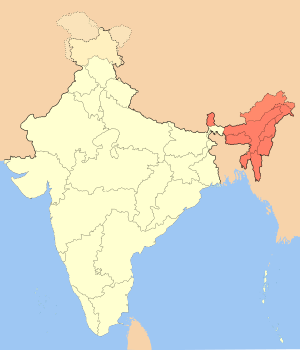Insurgency in North-east India facts for kids
The Insurgency in Northeast India refers to ongoing conflicts in the northeastern states of India. This region is connected to the rest of India by a narrow strip of land called the Siliguri Corridor. Various armed groups operate here. Some of these groups want their own separate state, while others seek more self-rule within India. A few extreme groups even demand complete independence from India. These conflicts have been happening for many years, affecting the lives of people in the region.
Contents
What is an Insurgency?
An insurgency is like a long-term rebellion or uprising against a government. It usually involves armed groups fighting against the official army or police. These groups often have strong political goals, such as gaining independence, changing the government, or getting more rights for their community. Insurgencies can last for a long time and often involve complex reasons, like history, culture, and economic issues.
Why is Northeast India Different?
Northeast India is a unique part of the country. It has many different ethnic groups, languages, and cultures. This region shares borders with several other countries, including Bhutan, China, Myanmar, and Bangladesh.
A Diverse Region
The eight states in Northeast India are:
Each state has its own distinct history and traditions. Many groups in these states have felt that their unique cultures and ways of life were not fully recognized or protected by the central government of India.
Historical Background
The roots of the insurgency go back to the time when India became independent in 1947. Before this, some parts of the Northeast were under British rule, while others were independent kingdoms. When these areas joined India, some local communities felt their wishes were not fully considered. This led to feelings of being left out or misunderstood.
Early Demands for Self-Rule
In the early years after independence, some groups started asking for more control over their own affairs. They wanted to protect their unique identities and resources. When these demands were not met, some groups decided to use armed force to achieve their goals.
What Do the Groups Want?
The armed groups in Northeast India have different aims. Understanding these aims helps explain why the conflicts continue.
Seeking Independence
Some groups believe that their region should be a completely separate country. They argue that their history and culture are very different from the rest of India. They often feel that their resources are not being used for the benefit of their own people.
Demanding More Autonomy
Other groups do not want full independence. Instead, they want more "autonomy," which means more self-rule or control over their own state's affairs. They want to make decisions about their land, culture, and economy without too much interference from the central government in Delhi. This often includes demands for special status or more power for local governments.
Protecting Ethnic Identity
Many conflicts in the Northeast are also about protecting the identity of specific ethnic groups. People want to preserve their language, traditions, and way of life. Sometimes, different ethnic groups within the Northeast also have conflicts with each other over land or resources.
How Has India Responded?
The Indian government has tried different ways to deal with the insurgency. These include military action, peace talks, and development programs.
Military Operations
The government has often used its army and police forces to fight against the armed groups. This involves trying to capture leaders, stop their activities, and maintain law and order. However, military action alone has not been able to completely end the conflicts.
Peace Talks and Agreements
Alongside military action, the government has also held peace talks with many insurgent groups. These talks aim to find peaceful solutions and reach agreements. Some groups have given up their weapons and joined the mainstream political process after signing peace accords. These agreements often involve promises of more development or greater autonomy for the region.
Focus on Development
The government also believes that improving the lives of people in the Northeast can help reduce the insurgency. This includes investing in roads, schools, hospitals, and job opportunities. The idea is that if people have better lives, they will be less likely to support armed groups.
Impact on People
The insurgency has had a big impact on the people living in Northeast India.
Daily Life Challenges
People in affected areas have faced challenges like violence, curfews, and disruptions to their daily lives. Businesses can be affected, and it can be difficult for children to go to school regularly.
Hope for Peace
Despite the challenges, many people in Northeast India hope for lasting peace. They want to live in a region where everyone can thrive and their unique cultures are celebrated. Efforts by local communities, civil society groups, and the government continue to work towards a peaceful future.


